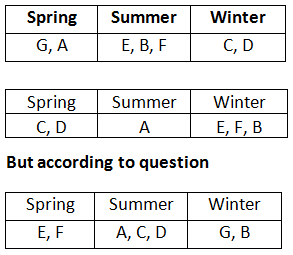Logical reasoning puzzles for cat: logical reasoning puzzles for cat that you should solve for better concept understanding
Logical reasoning puzzles for cat exam will help you greatly in grasping concepts by making them simpler for you. Learning concepts via the puzzle method is always fun and ensures long-lasting results as you develop a strong hold on concepts. With the help of Logical reasoning puzzles for cat most of the essentially tested areas can be covered and strengthened with the right amount of practice. If you nicely observe the Logical reasoning section of the CAT exam, you will find the sets resembling puzzles as you are required to use puzzle solving abilities in order to arrange and connect the given information. Therefore, going through a variety of logical reasoning puzzles for cat can help boost your performance.
Directions for the question set:
A commercial flower grower raises flowers in each of the three growing seasons every year-spring, summer and winter-with the year beginning in spring. Exactly seven different kinds of flowers- A, B, C, D, E, F and G-are grown every year. Each kind of flower is grown at least once a year. The flowers are grown according to the following rules:
(i) B can be grown in a growing season only if A is grown in the preceding season.
(ii) No more than three different kinds of flowers are grown in any one growing season.
(iii) No kind of flower can be grown in two seasons in a row.
(iv) A can be grown neither in the winter season nor in the same growing season as E or F.
(v) C and D are always grown in the same growing season.
Question 1: If G is grown in the spring and E in the summer of one year, then which of the following can also be grown in the summer?
(a) F
(b) A
(c) C
(d) D
Question 2: Which of the following is an acceptable from the table schedule for the three growing seasons?
Spring Summer Winter
(a) A C, D, B A, F, G
(b) C, F A, D, G B, E
(c) E, F A G, C, D, B
(d) A, C, D B, E, F G
Question 3: If G and B alone are grown in the winter season, then which of the following must be grown in the preceding spring?
(a) G
(b) B
(c) D
(d) E
Answers and Explanations: Click the down arrow to expand
And C and D are always grown in the same growing season. Four combinations are possible these are.

Arrangements 2 & 3 contradicting statement 1 (B can be grown in a growing season only if A is grown in the preceding season).
We left with only 2nd & & 4th arrangement.

Now it is given that
C and D are always grown in the same growing season.
B can be grown in a growing season only if A is grown in the preceding season.

Lastly, G will be with A
Final arrangements are below:

Answer 1: (a) From above it is clear that F could be grown in summer The correct option is (a)
Answer 2: (d) For the common solution for this set, refer to solution of Question 1. From (b), A cannot be grown in winter. Hence option (a) is eliminated. From (c), C and D come together Hence option (b) is also eliminated. From (a) More than three flowers are not possible in a season. Hence, option (a) is also eliminated. The correct option is (d)
Answer 3: (d) For the common solution for this set, refer to solution of Question 1. Our initial arrangement is

The correct option is (d)
Extra tips for logical reasoning puzzles for cat:
• Build an approach during the mock appearing stage to solve the logical reasoning puzzles for cat exam.
• While solving puzzles, it often happens that there are multiple possibilities in the initial steps. Make sure you account for those and do not miss considering any case.
• Logical reasoning puzzles for cat from various topics will help you sharpen analytical abilities, therefore pick topics and cover as many puzzles as you can.













